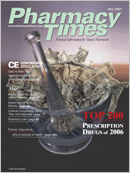Top 200 Prescription Drugs of 2006
Large increases in prescriptions forand sales of generics and biologicswere the major stories for the USpharmaceutical industry in 2006. (Seethe Top 200 tables on pages 36 and 37.)The primary driver of these trendsappears to have been the launch of thefull Medicare Part D benefit, as the programfor seniors and disabled individualsgreatly increased medication access topeople who, in the past, had no or verylimited drug coverage. Another majorfactor behind the continued rise ofgenerics was the market entry of multipleunbranded competitors to blockbusterssuch as Merck's Zocor (simvastatin)and Pfizer's Zoloft (sertraline).
Before proceeding to a discussion ofthose overall trends, here is a look at thenumbers for selected products and therapeuticcategories:
?Total drug sales increased by 8.3%from 2005, to $274.9 billion1
?Prescriptions dispensed grew to 3.7billion during the past year, an increaseof 4.6%
?Lipitor (atorvastatin; Pfizer) onceagain topped the lists of most commonlyprescribed and purchasedmedications
?Amgen's antianemia injectableAranesp (darbepoetin alfa) led allgainers among Top 20 earners, withan increase in revenues of 42%
?Statins, proton pump inhibitors, andantidepressants were the top-earningdrug categories. Antineoplasticmonoclonal antibodies, the 7thrankedclass, trailed only statins indollar growth.2
?New to the Top 20 list for prescriptionswere Advair Diskus (fluticasonepropionate and salmeterol xinafoate;GlaxoSmithKline), Mylan's furosemide,Teva's lisinopril, and Barr's warfarinsodium. The angiotensin-convertingenzyme inhibitor from Teva(lisinopril) rose the most, from 43rdplace in 2005 to 13th place in 2006.
?New to the Top 20 list for sales wereRemicade (infliximab; Centocor) andLexapro (escitalopram; Forest). Theymoved up from 21 and 23 to 18 and19, respectively.
More Patients Getting MoreGeneric Drugs
A telling statistic is that generic productsdispensed to Medicare Part D beneficiariesmade up 63% of the total prescriptionvolume last year.1 Medicarerequires coverage of nearly every drug inthe classes of antidepressants, antipsychotics,anticonvulsants, antiretrovirals,antineoplastics, and immunosuppressants.As the Part D rolls grow from thecurrent estimate of 24 million, and asmore generics become available, drugplans can be expected to choose lowercostproducts over higher-priced ones.3
Patients and payers also can expect tosee increasing numbers of generic drugapprovals and approvals of competitorsto brand name drugs. In 2006, the FDAapproved 371 generic drug products, upfrom 361 in 2005.4,5
More significant than the number,though, was the type. Important productsthat went off or lost their patent protectionin 2006 included Zoloft; Zocor;Plavix (clopidogrel; sanofi-aventis/Bristol-Myers Squibb); Pravachol (pravastatin;Bristol-Myers Squibb); and Mobic (meloxicam;Boehringer Ingelheim). The resultsof such an occurrence can be dramatic.To cite just 1 example, the lipid-loweringZocor dropped from 2nd place in thenumber of prescriptions in 2005 to 25thplace in 2006.1
Products that will have generic competitionfor the first time this year includePrevacid (lansoprazole; TAP) and Imitrex(sumatriptan; GlaxoSmithKline).6
Biologics Growing Rapidly
Interestingly, 6 generic products but nobiotech products are in the Top 20 prescribed,but the opposite is true for thelist of Top 20 drug sales. This disparitymay not be surprising when a year'sworth of unbranded lisinopril can cost aslittle as $300, but a week's worth ofAranesp therapy can cost more than$1000.7,8 The biotech segment's rapidgrowth in revenues, however, is attributablein part to the availability of Medicarecoverage for the products.
For the next 4 years, IMS Health forecastscontinued annual total pharmaceuticalsales growth in the range of 6% to 9%.Generics and biologics will continue to growmore rapidly than the entire market.1
Mr. Lamb is a freelance pharmacy writer living in Virginia Beach,Va, and president of Thorough Cursor Inc.
References
1. IMS Health. IMS Health reports U.S. prescription sales jump 8.3 percent in 2006, to$274.9 billion. Press release. March 8, 2007.
2. IMS Health. Top 10 Therapeutic Classes by U.S. Sales. IMS Health Web site.Available at:www.imshealth.com/ims/portal/front/articleC/0,2777,6599_80408854_80411855,00.html. Accessed March 11, 2007.
3. Centers for Medicare & Medicaid Services. Medicare drug plans strong and growing.Press release. January 30, 2007.
4. Buehler GJ. Office of Generic Drugs update. Presented at: Annual Meeting of theGeneric Pharmaceutical Association; Boca Raton, Fla; February 18, 2006.
5. US Food and Drug Administration, Office of Generic Drugs. Generic Drug Approvals.Office of Generic Drugs Web site. Available at:www.fda.gov/cder/ogd/approvals/default.htm. Accessed February 6, 2007.
6. US Food and Drug Administration. Electronic Orange Book. Available at:www.fda.gov/cder/ob. Accessed March 11, 2007.
7. drugstore.com. Available at:www.drugstore.com/qxn00591040601_333181_sespider/lisinopril/zestrilprinivil/lisinopril.htm. Accessed March 11, 2007.
8. Bio Scrip. Available at:www.scrippharmacy.com/mimrx/drug_pricing.asp?index=A&searchtext=&brand_name=Aranesp&gpi10_code=8240101512&mscssid=. Accessed March 11, 2007.

